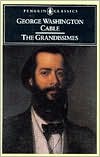

 |

|

The average rating for The Grandissimes: A Story of Creole Life based on 2 reviews is 4.5 stars.
Review # 1 was written on 2008-02-09 00:00:00 Laprade Sebastien Laprade SebastienA reread, this time on my Kindle via a Gutenberg download: I highlighted tons of passages to share, along with some non-English words to look up. I took the Kindle on a trip, reading from it on the plane, both ways. At home, the night after my return, at about the 80% mark, all my highlighting had mysteriously disappeared (in this document only, not in others): the equivalent of a ton of Post-it notes falling out of a physical book for no discernible reason. (Urrrgh!) Oh, well. Those beautiful, gone-with-the-wind sentences described, at least for me, present-day New Orleans; though the novel is set immediately post-Louisiana Purchase. Yet, as my reading buddy emphasized, what has changed are the white (European) Creoles: they are no more, disappearing even as they doth-protested-too-much their presumed superiority (due to their so-called pure whiteness), kicking-and-screaming the whole way, and despite the reality of the progeny of mixed-race unions and the illogicality of their beliefs. George Washington Cable, born in New Orleans, called theirs "a doomed civilization" (at the Kindle-93% point of the novel) and he was despised for speaking the truth. The story is of complicated topics'identity (including of caste and class) and its entrenchment'and is told with realism, sentiment and irony. I read it with sadness, knowing that Cable's championing of racial (and gender) equality was not accepted then and, in so many ways, is not accepted still. |
Review # 2 was written on 2021-01-04 00:00:00 Brian Orach Brian OrachGeorge Washington Cable's The Grandissimes is an odd book about Creole life in New Orleans right around the time of the Louisiana Purchase. The city had been under Spanish control for some thirty years, after having been founded by the French. Then, as Napoleon occupied Spain, it became French again for a short time before he decided to sell it (and a whole lot besides) to the United States for $15 million. The story is seen from the point of view of an American pharmacist of German extraction named Joseph Frowenfeld who finds himself confused by the strict punctilio of human relations between the White Creoles, the Partly White Creoles who are classified as f.p.c. (free persons of color), and the black slaves. Cable himself was quite liberal in his views of the slaves, mulattoes, and quadroons. At one point, he writes:As for us, our feelings, our sentiments, affections, etc., are fine and keen, delicate and many; what we call refined. Why? Because we get them as we get our old swords and gems and laces--from our grandsires, mothers, and all. Refined they are--after centuries of refining. But the feelings handed down to Clemence had come through ages of African savagery; through fires that do not refine, but that blunt and blast and blacken and char; starvation, gluttony, drunkenness, thirst, drowning, nakedness, dirt, fetichism, debauchery, slaughter, pestilence and the rest--she was their heiress; they left her the cinders of human feelings. She remembered her mother. They had been separated in her childhood, in Virginia when it was a province. She remembered, with pride, the price her mother had brought at auction, and remarked, as an additional interesting item, that she had never seen or heard of her since. She had had children, assorted colors--had one with her now, the black boy that brought the basil to Joseph; the others were here and there, some in the Grandissime households or field-gangs, some elsewhere within occasional sight, some dead, some not accounted for. Husbands--like the Samaritan woman's.Much of the dialog in the book is in a weird Franco-Creole-African patois that is hard to follow, but which lends authenticity to the strangeness of the culture circa 1803-1804. The heaviest patois is from the delightful mother/daughter duo of Aurore and Clotilde de Grapion, with whom half the characters in the novel appear to be in love. The forces of conservatism are represented by Agricole Fusilier de Grandissime, who, like many of his like-minded friends, thinks that the American presence in New Orleans will not last, and that the city once again will become French. There are two characters named Honore Grandissime, who happen to be half brothers. The 100% white brother and his quadroon sibling lead to a lot of confusion, particularly at the beginning of the story, but they come together in an interesting way at the end. Also notable is the character of Palmyre Philosophe, loved by Honore f.p.c., a practitioner of voudou. As difficult as it sometimes is, The Grandissimes is a delightful book that preceded most of what we call the literature of the South, and influenced it in many ways too numerous to mention. I do believe that William Faulkner must have had a copy of the book close to his bedside. |
CAN'T FIND WHAT YOU'RE LOOKING FOR? CLICK HERE!!!